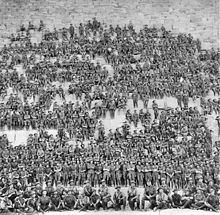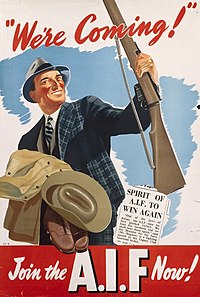Australian Imperial Force
The Australian Imperial Force ( AIF ) was an Australian Army in the First and Second World War for use overseas. According to the Defense Act of 1903, only volunteers were allowed to fight outside Australian territory, which is why the AIF was a volunteer army .
1st AIF
AIF was set up as a volunteer army after England declared war on Germany on August 15, 1914 and remained so in contrast to the British army , which introduced conscription . In 1914 the AIF was seen and referred to as “the” AIF. The addition "1st" was only introduced in the Second World War to make the distinction from the new troop clear.
During the First World War, 331,814 AIF soldiers fought for Great Britain , whose dominion was Australia. That was 13% of Australia's white male population. In addition, 2,100 women served mainly as nurses in the AIF. Initially, only an infantry division and a light cavalry brigade were planned. Australia wanted to provide a total of 20,000 men, including all the necessary support workers. But then 5 infantry divisions were set up, of which each division had 3 brigades with 4 battalions of 1,000 men each. Unlike the British Army, the Australian Army had no regiments , but numbered its battalions from 1 to 60. Each battalion was recruited from a specific geographical region, so that an identity of the individual units developed in the course of the war. The AIF was deployed on the Suez Canal , the Battle of Gallipoli , Gaza and on the Western Front. 64% of the soldiers were wounded and 18% died. Australians received numerous awards during World War I. 64 soldiers alone received the Victoria Cross , the highest award for bravery in the armed forces of the United Kingdom and the Commonwealth.
After the war there were 92,000 soldiers in France, 60,000 in England, 17,000 in the Middle East, and nurses in Salonika and India. The 1st AIF was dissolved on April 21, 1921.
The 1st Australian Imperial Force consisted of:
- 5 Divisions Infantry
- 2 Australian and New Zealand Army Corps (ANZAC)
- Royal Australian Navy
- Australian Flying Corps (AFC), founded in 1914, now Royal Australian Air Force (RAAF)
- Australian Cavalry.
2nd AIF
During the Second World War , the 2nd AIF was set up on September 15, 1939 . Prime Minister Robert Menzies planned to set up an infantry division with 20,000 men and auxiliary troops as far as they could provide the troops, which were dependent on volunteers alone. On November 15, 1939, conscription was introduced for the homeland security troops with effect from April 1, 1940. All unmarried men between the ages of 20 and 35 were obliged to serve. After the defeat of France in the summer of 1940, the number of volunteers grew so rapidly that two more divisions could be set up. At the beginning the 2nd AIF had insufficient armament, which consisted of weapons from the 1st AIF. It took a while for Australian industry to convert its production to the weapons necessary for a modern army, because British industry was busy with equipping its own army. After the outbreak of the war in the Pacific, experienced soldiers from the ranks of the 2nd AIF were transferred to the homeland security units as reinforcements and homeland security units with more than 75% AIF soldiers were then also allowed to call themselves Australian Imperial Forces.
In November 1944 there were 423,000 soldiers (including 307,000 AIF) and 25,000 women in the Australian Army. Australian troops fought in the Middle East, North Africa and Greece, as well as in the Pacific and Southeast Asia. Twenty 2nd AIF soldiers received the Victoria Cross , the highest distinction in the United Kingdom and Commonwealth Army , during World War II .
The 2nd AIF was part of the Australian Military Forces (AMF) together with the Permanent Military Force (PMF) and Citizen Military Force (CMF ). It was dissolved on June 30, 1947 and the remaining personnel transferred to the Australian Army .
The 2nd Australian Imperial Force consisted of:
- 4 infantry divisions and 1 armored division
- 3 volunteer divisions, including 2 armored divisions.
Web links
- The AIF Project , UNSW Canberra at the Australian Defense Force Academy
Individual evidence
- ↑ spartacus.schoolnet In the Third Battle of Flanders , the Australian units lost 38,000 soldiers to death or wounding.
- ^ Long, Gavin (1963). The Final Campaigns (PDF). Official Histories - Second World War pp. 19-20. Australian War Memorial
- ↑ WWII Nominal Roll Australia Overview, English

